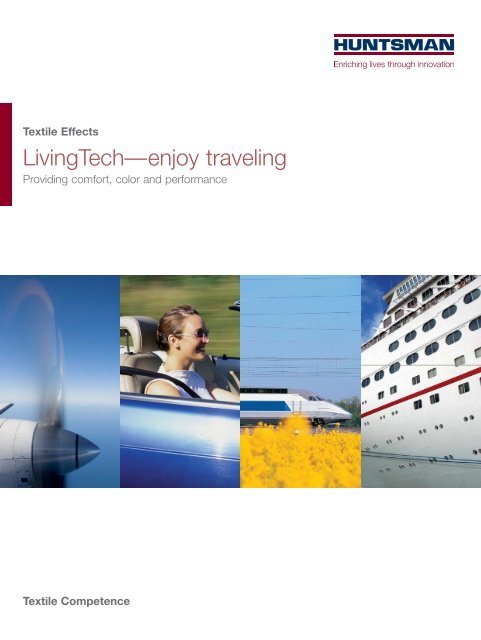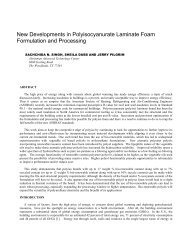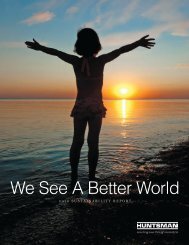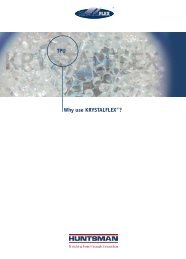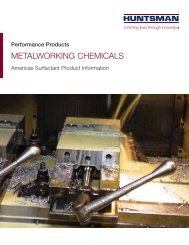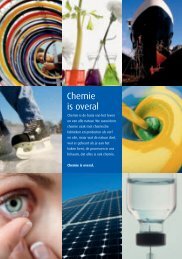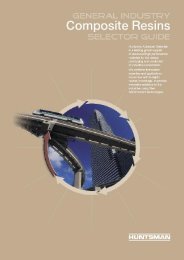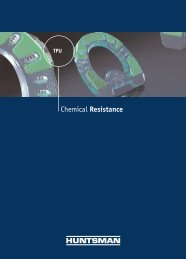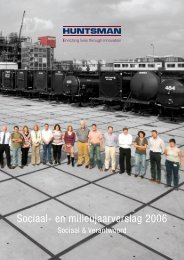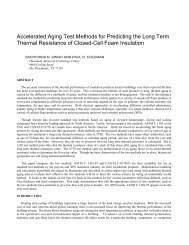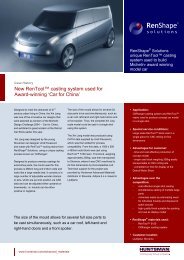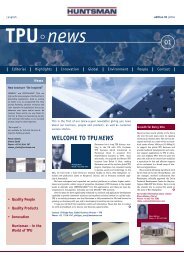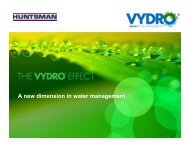LivingTech—enjoy traveling
LivingTech—enjoy traveling
LivingTech—enjoy traveling
Create successful ePaper yourself
Turn your PDF publications into a flip-book with our unique Google optimized e-Paper software.
Textile Effects<br />
<strong>LivingTech—enjoy</strong> <strong>traveling</strong><br />
Providing comfort, color and performance<br />
Textile Competence
<strong>LivingTech—enjoy</strong> <strong>traveling</strong><br />
People on the move—travel has become an integral part of modern life.<br />
Whether it be commuting on a daily basis, transcontinental business travel or<br />
tourism, at any given point in time billions of people are on the move.<br />
Because travel represents for such a significant aspect of our daily lives,<br />
issues such as comfort and safety have taken on a high priority.<br />
Functional textiles fulfill exactly these needs and contribute on the one hand<br />
towards greater comfort through their handle and on the other through visual<br />
appeal.<br />
Over and above the comfort element, functional textiles also fulfill an extremely<br />
important role—that of safety both for public and private transportation.<br />
The main features and requirements of functional textiles are:<br />
• Light-weight (fuel saving >> reduction of CO2-emissions) • Fireproof (flame retardant >> safety)<br />
• Light-fastness (value stability)<br />
• Abrasion resistance<br />
• Anti pilling<br />
• Liquid repellency<br />
• Color fastness to perspiration, dry cleaning, rubbing, washing and water<br />
• Breaking strength and elongation
L i v i n g T e c h<br />
Enjoy car travel<br />
In modern society life without cars is virtually unthinkable<br />
and the automobile has moved from being just a means<br />
of transportation to becoming both an essential commodity<br />
as well as a status symbol. People spend so much<br />
time in their cars that the expectations are now similar to<br />
those of a home. Accordingly there is also an increasing<br />
trend to consume food and drink in cars. Regardless of<br />
these factors, consumers wish for the interiors to be visually<br />
and sensually aesthetic and remain that way. First<br />
class fabrics in car interiors can make all the difference!<br />
Ranking of key functions and effects—<br />
functional textiles for automotives:<br />
• Durability<br />
(high temperature light-fastness, abrasion resistance)<br />
• Function and performance<br />
(oil, water and stain repellency, antistatic)<br />
• Safety and protection<br />
(flame retardant properties)<br />
• Cost savings<br />
(enhanced productivity)<br />
Single effects and various effect combinations are possible.<br />
Typical functional textiles used in automotives:<br />
• Upholstery (seat covers) and carpets (tufted, needled)<br />
• Seatbelts and airbags<br />
• Filters (nonwovens such as cabin filters, engine<br />
filters, fuel filtration)<br />
• Head liners and hood liners<br />
• Trims (woven and knitted, for e.g. boot liners, head<br />
liners, door panels)<br />
• Luggage racks (nets) and luggage covers<br />
• Soft tops for convertibles<br />
Durability<br />
Car interiors are permanently exposed to severe conditions<br />
such as extreme temperatures, humidity, bright and<br />
low light, dust and dirt. Functional fabrics for automotive<br />
applications therefore need to achieve the highest degree<br />
of durability with respect to shade stability and abrasion<br />
resistance.<br />
Function and performance<br />
Reflecting today’s fast-moving lifestyle, food and drinks<br />
are regularly consumed in cars. With this trend the risk of<br />
spillage is very high and automotive fabrics have to be<br />
able to protect against staining from foodstuffs. A repellent<br />
function helps protect the material against stains, and<br />
a release function helps improve the cleanability of fabrics<br />
where stains are rubbed into the fabric structure.<br />
Another important performance feature for car textile interiors<br />
must be the ability to counteract against the build up<br />
of electrostatic charges (antistatic effect). This is a common<br />
problem familiar to everyone who has ever received<br />
an unpleasant “electric shock” caused by a combination<br />
of fiber selection, friction and humidity.<br />
Safety and protection<br />
Polyester and polyamide, synthetic fibers used for automotive<br />
interiors are extremely flammable. A glowing cigarette<br />
or a smoldering matchstick could easily ignite and<br />
start a fire. A flame retardant function is a must for functional<br />
textiles used in cars to prevent the fabric from<br />
catching fire.<br />
Cost saving<br />
Part of the optimized production processes which lead to<br />
increased output and cost reduction comes from minimizing<br />
second dyeing, spots and other reworking of fabrics<br />
for car interiors.<br />
Desired functions and effects for textiles used<br />
in private transportation vehicles:<br />
• Flame retardancy<br />
• Oil, water and stain repellency<br />
• Durability of oil, water and stain repellency effect after<br />
abrasion<br />
• Abrasion resistance of fabric<br />
• Anti pilling<br />
• Antistatic<br />
• High temperature light-fastness<br />
• Shampoo fastness<br />
• Non fogging<br />
• Hydrolysis resistance<br />
• Molding resistance<br />
• Operating fluids resistance<br />
• High temperature resistance<br />
• Resistance to prolonged heat exposure
L i v i n g T e c h<br />
Enjoy flying<br />
With globalization, the air transport industry plays a crucial<br />
economic role with rapid intercontinental connections.<br />
Furthermore, increasing competition in the skies makes air<br />
travel much more affordable—a boost for the tourism<br />
industry. Statistics show that more than 2 billion passengers<br />
are annually transported by airlines which translates<br />
to 30% of the world’s population. These figures are on<br />
the rise at the rate of nearly 5% per annum. Judging by<br />
these numbers one can assume that passengers expect<br />
a high degree of comfort, even luxury on their flight.<br />
Functional textiles play a significant role in contributing to<br />
the in-flight well-being of passengers through design and<br />
aesthetics as well as handle and performance.<br />
Ranking of key functions and effects—<br />
functional textiles for planes:<br />
• Safety and protection<br />
(flame retardant properties)<br />
• Cost and resource saving<br />
(weight reduction = CO2 reduction)<br />
• Function and performance<br />
(oil, water and stain repellency, antistatic)<br />
• Durability<br />
(abrasion resistance)<br />
Single effects and various effect combinations are possible.<br />
Analog to the key requirements of functional textiles used<br />
in other means of transportation with different emphasis<br />
on each specific function and effect!<br />
Functional textile elements in planes:<br />
• Upholstery (seat covers)<br />
• Cushion covers<br />
• Curtains<br />
• Carpets<br />
• Headrests<br />
• Wall coverings<br />
• Filters<br />
• Blankets<br />
• Safety belts<br />
Even more stringent performance and safety standards<br />
apply to furnishing and other accessory textiles used in<br />
aviation.<br />
High on the priority list of regulations are the flame<br />
retardant (FR) properties of fabrics used in planes. The<br />
decisive criterion takes the worst case scenario: fire in a<br />
closed cabin during the flight and the time for an emergency<br />
landing including evacuation of the passengers.<br />
Given this criterion, FR-standards not only include the<br />
flammability and burning behavior of the fabric but also<br />
the measurement of the heat release, smoke density and<br />
development of toxic gases like carbon monoxide, hydrogen<br />
cyanide, nitrous gases and hydrogen fluoride.<br />
Textiles in planes have to perform at a very high level with<br />
regard to durability, cleanability and fastness. The following<br />
examples demonstrate the expectations on functional<br />
textiles.<br />
Seat covers are demounted 3–5 times a year and externally<br />
dry cleaned. They have a life expectancy of 2.5<br />
years.<br />
Carpets in the aisle are subject to constant stress<br />
caused by the catering trolleys. These carpets have to be<br />
replaced every three months.<br />
Just these two examples and the fact that it is estimated<br />
that China alone will need around 2000 wide-bodied<br />
aircraft by the year 2020 highlights the potential for functional<br />
textiles in this segment.<br />
Desired and statutory effects for textiles used<br />
in planes:<br />
• Flame retardancy including low development of toxic<br />
fumes in case of a fire and heat release (passenger<br />
safety has top priority)<br />
• Oil, water and stain repellency<br />
• Durability of oil, water and stain repellency effect after<br />
abrasion<br />
• Abrasion resistance of fabric<br />
• Anti pilling<br />
• Antistatic<br />
• Colorfastness to artificial light<br />
• Antistatic<br />
• Dry cleaning fastness<br />
• Washing fastness<br />
• Rubbing fastness
L i v i n g T e c h<br />
Enjoy train travel<br />
With growing congestion in major cities around the world<br />
and increasing fuel costs, public transportation is fast<br />
becoming the transportation means of choice.<br />
To meet this demand and to make public transport more<br />
attractive, the industry needs to meet consumer expectations<br />
of comfort, cleanliness and safety.<br />
This is where performance furnishing materials play a key<br />
role by providing aesthetic appeal whilst at the same time<br />
demonstrating durability and safety—especially with flame<br />
retardancy.<br />
Ranking of key functions and effects—<br />
functional textiles for trains and coaches:<br />
• Safety and protection<br />
(flame retardant properties)<br />
• Durability<br />
(abrasion resistance, antivandalism)<br />
• Function and performance<br />
(oil, water and stain repellency, antistatic)<br />
Single effects and various effect combinations are possible.<br />
Analog to the key requirements of functional textiles used<br />
in other means of transportation with different emphasis<br />
on each specific function and effect!<br />
Typical functional textiles in public<br />
transportation vehicles:<br />
• Upholstery (seat covers, e.g. velvet pile, flat woven)<br />
• Curtains<br />
• Carpets for trains<br />
• Filters<br />
• Headrests<br />
• Roller blinds and sunshades<br />
• Safety belts (mainly coaches)<br />
• Luggage racks<br />
Safety considerations in more advanced markets are<br />
already leading to many public service vehicles being<br />
equipped with seat belts. Some observers see this area<br />
as eventually being an important new extension to the<br />
market for air bag technology.<br />
Desired and statutory effects for textiles used<br />
in public transportation vehicles:<br />
• Flame retardancy including low development of toxic<br />
fumes in case of a fire (passenger safety has top priority)<br />
• Oil, water and stain repellency<br />
• Durability of oil, water and stain repellency effect<br />
after abrasion<br />
• Abrasion resistance of fabric<br />
• Anti pilling<br />
• Antistatic<br />
• Combination of antimicrobial finish with oil and water<br />
repellency<br />
• Light-fastness<br />
• Antivandalism effect (destruction of fabric by sharp<br />
objects such as knives or pens) >> selection of special<br />
fibers and fiber construction
L i v i n g T e c h<br />
Enjoy cruising<br />
The cruise industry is one of the fastest growing segments<br />
in tourism—growing by more than 2,100 % since<br />
1970, when an estimated 500,000 people took a cruise.<br />
More than 12 million people took a cruise in 2006.<br />
Industry estimates are that 500,000 more will cruise in<br />
2007.<br />
The cruise industry’s growth is also reflected in its<br />
expanding guest capacity. Nearly 40 new ships were built<br />
in the 1980s and in the 1990s nearly 80 new ships were<br />
launched. By the end of 2007, 88 new ships will have<br />
been introduced since 2000.<br />
Modern cruise ships are “swimming luxury hotels”, which<br />
by their very nature require, especially in the cabins,<br />
enormous quantities of textiles. Cruise ships therefore<br />
represent an expanding segment for the implementation<br />
of functional textiles.<br />
Ranking of key functions and effects—<br />
functional textiles for cruise ships:<br />
• Safety and protection<br />
(flame retardant properties)<br />
• Function and performance<br />
(oil, water and stain repellency, antistatic)<br />
• Durability<br />
(abrasion resistance)<br />
Single effects and various effect combinations are possible.<br />
Analog to the key requirements of functional textiles used<br />
in other means of transportation with different emphasis<br />
on each specific function and effect!<br />
The list of functional textiles used on board<br />
cruise ships demonstrates the potential for this<br />
segment:<br />
• Upholstery (seat covers)<br />
• Cushion covers<br />
• Curtains<br />
• Roller blinds, vertical blinds<br />
• Carpets<br />
• Wall coverings<br />
• Tablecloths<br />
• Fabric for chairs, sofas and beds<br />
• Lamp shades<br />
• Fabric for deck chairs<br />
• Awnings and sun shades<br />
• Umbrellas<br />
Although most of the above belong to the home textile<br />
family with similar requirements, these functional textiles<br />
must provide enhanced performance at all levels for<br />
thousands of people.<br />
Desired and statutory effects for textiles used<br />
in cruise ships:<br />
• Flame retardancy including low development of toxic<br />
fumes in case of a fire (passenger safety has top priority)<br />
• Oil, water and stain repellency<br />
• Durability of oil, water and stain repellency effect<br />
after abrasion<br />
• Abrasion resistance of fabric<br />
• Hydrolysis resistance<br />
• Anti pilling<br />
• Antistatic<br />
• Colorfastness to artificial light<br />
• Light-fastness<br />
• Antistatic<br />
• Dry cleaning fastness<br />
• Perspiration, water and washing fastness<br />
• Sea water fastness<br />
• Rubbing fastness
www.huntsman.com/textile_effects<br />
Region Europe<br />
Huntsman Textile Effects (Germany) GmbH<br />
Rehlinger Straße 1<br />
86462 Langweid a. Lech, Germany<br />
Telephone +49 8230 41-0<br />
Fax +49 8230 41-370<br />
infotexeurope@huntsman.com<br />
Region Americas<br />
Huntsman International LLC<br />
Textile Effects<br />
4050 Premier Drive<br />
High Point, NC 27265, USA<br />
Telephone +1 800 822 1736<br />
Fax +1 336 801 2808<br />
infotexamericas@huntsman.com<br />
Region Asia<br />
Huntsman (Guangdong) Ltd.<br />
Textile Effects<br />
Flying Geese Mountain Industrial Park<br />
Shilou Town, Panyu District, Guangzhou<br />
511447, PR China<br />
Telephone +86 20 8484 5100<br />
Fax +86 20 8484 5222<br />
infotexasia@huntsman.com<br />
Edition 2007<br />
Copyright © 2007 Huntsman. All rights reserved.<br />
All trademarks mentioned are registered trademarks of Huntsman Corporation<br />
or an affiliate thereof in one or more, but not all countries.<br />
IMPORTANT: The following supersedes Buyer’s documents. Sales of the<br />
product described herein (“Product”) are subject to the general terms and conditions<br />
of sale of either Huntsman Advanced Materials LLC, or its appropriate<br />
affiliate. Huntsman warrants that at the time and place of delivery all Products<br />
sold to Buyer shall conform to the specifications provided to Buyer by<br />
Huntsman.<br />
While the information and recommendations included in this publication are,<br />
to the best of Huntsman’s knowledge, accurate as of the date of publication,<br />
NOTHING CONTAINED HEREIN (EXCEPT AS SET FORTH ABOVE REGARDING<br />
CONFORMANCE WITH SPECIFICATIONS PROVIDED TO BUYER BY HUNTSMAN)<br />
IS TO BE CONSTRUED AS A REPRESENTATION OR WARRANTY OF ANY KIND,<br />
EXPRESS OR IMPLIED, INCLUDING BUT NOT LIMITED TO ANY WARRANTY OF<br />
MERCHANTABILITY OR FITNESS FOR A PARTICULAR PURPOSE, NONIN-<br />
FRINGEMENT OF ANY INTELLECTUAL PROPERTY RIGHTS, OR WARRANTIES<br />
AS TO QUALITY OR CORRESPONDENCE WITH PRIOR DESCRIPTION OR<br />
SAMPLE, AND THE BUYER ASSUMES ALL RISK AND LIABILITY WHATSOEVER<br />
RESULTING FROM THE USE OF SUCH PRODUCT, WHETHER USED SINGLY OR<br />
IN COMBINATION WITH OTHER SUBSTANCES.<br />
No statements or recommendations made herein are to be construed as a<br />
representation about the suitability of any Product for the particular application<br />
of Buyer or user or as an inducement to infringe any patent or other intellectual<br />
property right. Buyer is responsible to determine the applicability of such information<br />
and recommendations and the suitability of any Product for its own<br />
particular purpose, and to ensure that its intended use of the Product does not<br />
infringe any intellectual property rights.<br />
The Product may be or become hazardous. The Buyer should obtain Material<br />
Safety Data Sheets and Technical Data Sheets from Huntsman containing<br />
detailed information on Product hazards and toxicity, together with proper<br />
shipping, handling and storage procedures for the Product, and should comply<br />
with all applicable governmental laws, regulations and standards relating to the<br />
handling, use, storage, distribution and disposal of, and exposure to the<br />
Product. Buyer shall also take all steps necessary to adequately inform, warn<br />
and familiarize its employees, agents, direct and indirect customers and contractors<br />
who may handle or be exposed to the Product of all hazards pertaining<br />
to and proper procedures for safe handling, use, storage, transportation and<br />
disposal of and exposure to the Product, and the containers or equipment in<br />
which the Product may be handled, shipped or stored.<br />
Please note that products may differ from country to country. If you have any<br />
queries, kindly contact your local Huntsman representative.<br />
Huntsman is a member of:<br />
(Ecological and Toxicological Association of Dyes and Organic<br />
Pigments Manufacturers)<br />
0600046e—May 2007, Printed in Germany.


